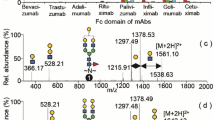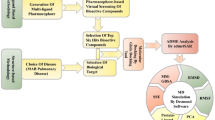Abstract
In this paper the biochemical properties of the antigens detected by six murine monoclonal antibodies (MAbs) are described. These MAbs react selectively with the multidrug-resistant small cell lung cancer (SCLC) cell line, H69AR, compared to its sensitive parent cell line, H69 (Mirski & Cole, 1989). Because H69AR cells do not overexpress P-glycoprotein, the antigens detected by these MAbs may be markers for non-P-glycoprotein-mediated mechanisms of resistance. We found that the 36 kDa protein precipitated by MAb 3.186 is phosphorylated and has a pI of approximately 6.7. The 55 kDa protein precipitated by MAb 3.50 is also phosphorylated and has a pI of approximately 5.7. Several observations suggest that MAbs 3.80, 3.177 and 3.187 recognise the same 47 kDa molecule and hence only MAb 3.187 was characterised further. This MAb precipitates an acidic protein which runs as a streak on isoelectric focusing gels. The 25 and 22.5 kDa cell surface proteins precipitated by MAb 2.54 both have a pI of approximately 7.6. Treatment of immunoprecipitates with glycosidase F indicated that none of the proteins detected by MAbs 2.54, 3.187, 3.50 and 3.186 have large N-linked carbohydrates. The peptide nature of the epitopes detected by MAbs 2.54 and 3.186 was unequivocally demonstrated by precipitation from in vitro translation products of H69AR RNA. The antigens detected by MAbs 3.50 and 3.187 were not detectable in immunoprecipitates of translation products but the epitopes are probably peptides because they were destroyed by boiling in sodium dodecyl sulphate. When the reaction of the MAbs with a panel of 15 paired drug-sensitive and -resistant cell lines was examined in a cell enzyme-linked immunosorbent assay, only a few resistance associated reactions were observed. Most of the reactions were either negative or not resistance-associated. When tested with three SCLC cell lines, MAb 3.187 reacted in a manner consistent with the relative resistance of the cell lines. Antigens that had similar electrophoretic mobility to those from H69AR cells were precipitated from extracts of five human cell lines of various tumour types. These data indicate that the cross-reactivities of the MAbs are due to antigens shared among the cell lines and not just the expression of common epitopes on different proteins. Resistance-associated proteins with the biochemical properties of the antigens described in this paper have not been reported previously and they remain potential markers for the as yet to be determined mechanisms of drug resistance in SCLC and other human malignancies.
This is a preview of subscription content, access via your institution
Access options
Subscribe to this journal
Receive 24 print issues and online access
$259.00 per year
only $10.79 per issue
Buy this article
- Purchase on SpringerLink
- Instant access to full article PDF
Prices may be subject to local taxes which are calculated during checkout
Similar content being viewed by others
Author information
Authors and Affiliations
Rights and permissions
About this article
Cite this article
Mirski, S., Cole, S. Multidrug resistance-associated antigens on drug-sensitive and -resistant human tumour cell lines. Br J Cancer 64, 15–22 (1991). https://doi.org/10.1038/bjc.1991.232
Issue date:
DOI: https://doi.org/10.1038/bjc.1991.232
This article is cited by
-
Human cell lines as models for multidrug resistance in solid tumours
Cytotechnology (1993)



